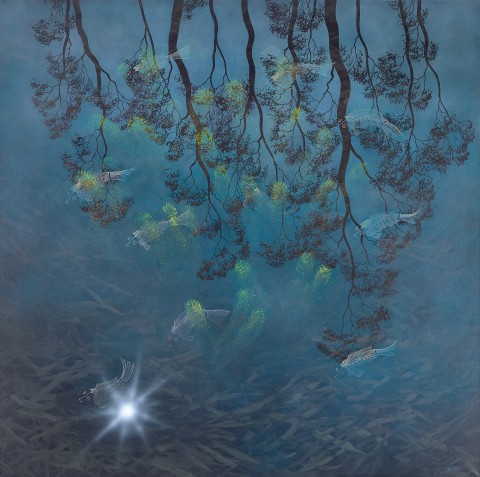REFLECTIONS (BARMAH FOREST), 1994 – 95
LIN ONUS
synthetic polymer paint on canvas
182.0 x 182.0 cm
signed lower right: Lin Onus
IAG Collection, Sydney
Private collection, Sydney, acquired 2002
The paintings of Lin Onus present a complex mixture of ideas around place, ownership and history and occupy a distinctive position in the broader setting of Australian art. Extraordinarily beautiful and technically flawless, works such as Reflections (Barmah Forest), 1994 – 95 are full of meaning with a capacity to transfix the viewer. As Michael O’Ferrall observes, ‘the sheer tactility of Lin Onus’ imagery establishes a carefully balanced dialogue of sensory and mental elements’.1 Renowned for incorporating satire and humour in his early political installations and paintings to challenge cultural hegemonies, it is in these later paintings that Onus demonstrated his Indigenous connection to country. Poetic landscapes of the natural world combined with subtle traditional iconography thus confirm Onus’ relationship to both his adopted homeland in Arnhem Land and to his own ancestral sites at the Barmah Forest on the Murray River.
Growing up in a culturally-fertile and politically-engaged household in Melbourne, Lin Onus could not help but be influenced by the activism of his family. His mother Mary Kelly was of Scottish origin and an active member of the Australian communist party, while his father Bill Onus, a Yorta Yorta man, was an important figure in the Aboriginal civil rights movement. Just as the overtones of bullying and racism experienced by Onus in 1960s suburban Melbourne coloured much of his art, so too being immersed in ideas of learning, artistry and community – augmented by the cultural revelations that came from his friendship with respected painter Jack Wunuwun (1930 – 1991) – enabled Onus to embrace both his indigenous and non-indigenous heritage and to expound his distinctive hybrid style which integrated Indigenous spirituality and narrative with Western representation.
A translucent and multi-layered painting, Reflections (Barmah Forest) recalls Onus’ spiritual home of the Barmah Forest, a unique wetland comprising the largest red river gum forest in the world, whose ecology is influenced by seasonal changes to waterflows from the adjacent Murray River. This painting belongs to a body of work produced between 1994 and 1996 which evolved following Onus’ regular ‘spiritual pilgrimages’2 to Arnhem Land where he spent time with Jack Wunuwun, his adoptive father and mentor. Wunuwun was known for pioneering the rendering of three dimensions and perspective in bark painting by drawing on influences from European art. Onus’ watery landscapes embrace what Wunuwun described as ‘seeing below the surface’3 and function on a number of levels. A landscape apparently hangs from the sky, the brilliant midday sun reflected in the still water illuminates the detritus below and a school of rarrk-covered fish swimming both under the water and seemingly through the skies. As Margo Neale elaborates, these paintings are ‘deceptively picturesque, for things are not always what they seem. Laden with cross-cultural references, visual deceits, totemic relationships and a sense of displacement, they, amongst other things, challenge one's viewing position: are you looking up through water towards the sky, down into a waterhole from above, across the surface only or all three positions simultaneously?’4
Activist and friend Gary Foley described Lin Onus as ‘an artist first and a politician second … he expressed himself through his art, and in doing so created some of the most powerful political statements of his era.’5 His art addressed issues and points of view that were deeply personal yet spoke to broader national and international concerns. Onus wanted to remind people that beneath the surface of everything was history and tradition, and he hoped ‘that history may see him as some sort of bridge between cultures’.6
1. O’ Ferrall, M., ‘Lin Onus’ in Australian Perspecta 1991, Art Gallery of New South Wales, Sydney, 1991 p. 80
2. Onus cited in Neale, M., Urban Dingo: The Art of Lin Onus 1948–1996, Queensland Art Gallery, Brisbane, 2000, p. 15
3. Neale, M. et al, Lin Onus: A Cultural Mechanic, Savill Galleries, Melbourne (exhibition catalogue), 2003, p. 1
4. Ibid.
5. Foley G., ‘Lin Onus: A personal/political memory’ in Neale, M., Urban Dingo: The Art of Lin Onus 1948–1996, Queensland Art Gallery, Brisbane, 2000, p. 33
6. Neale, op. cit., 2000, p. 21
CRISPIN GUTTERIDGE
